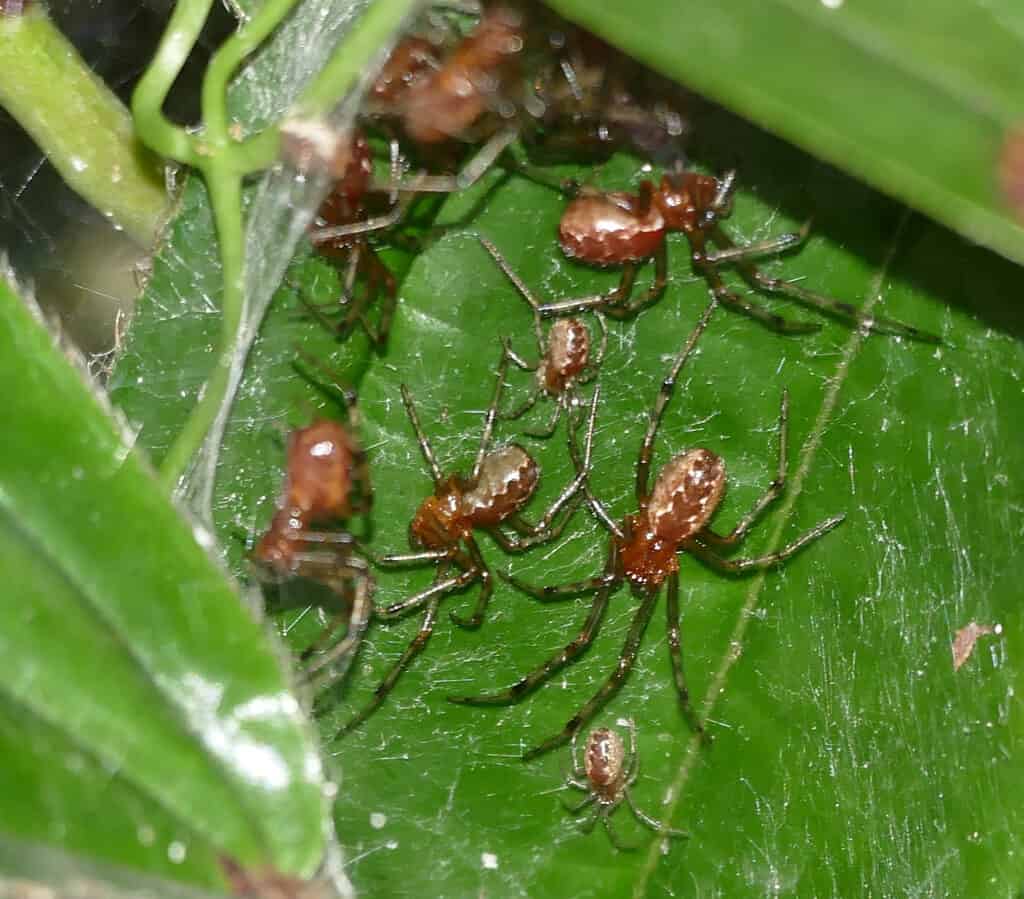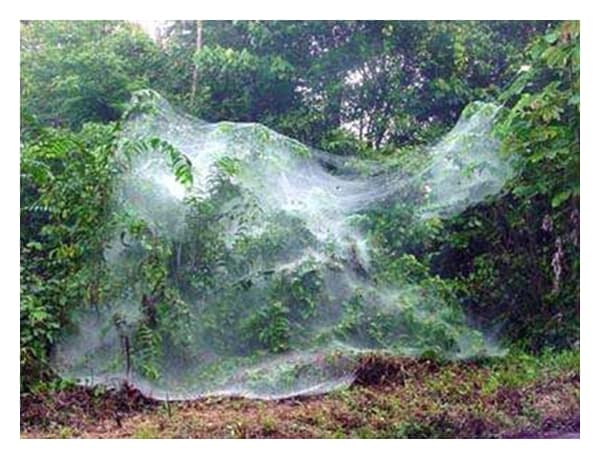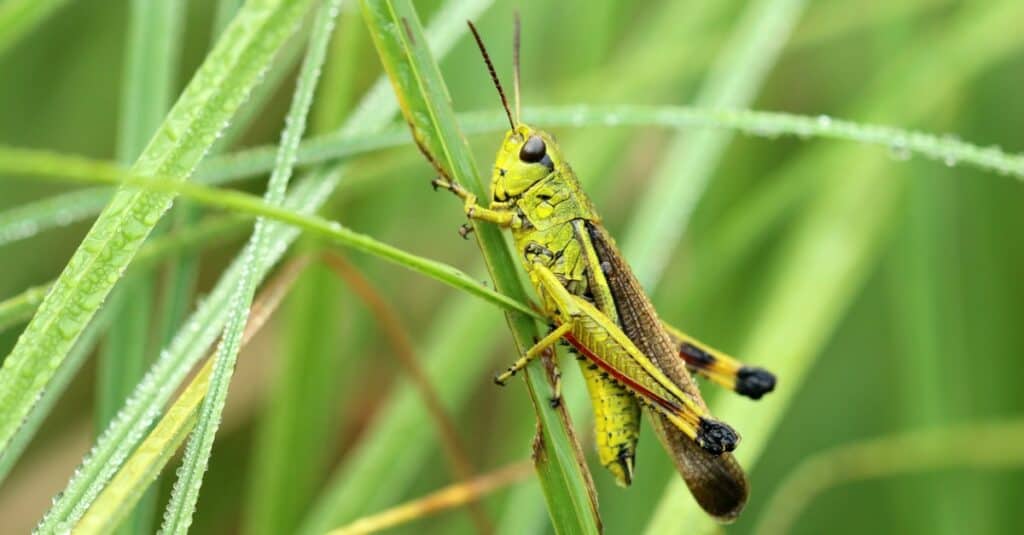Key Points:
- Anelosimus eximius is one of the 20-30 spider species that live in social groups, which range from 20 to 100 spiders to large colonies of up to 1,000.
- These spiders about 5-6 mm long can build webs the size of a school bus. Once prey gets caught in their immense web spanning several trees, the arachnids close in. The larger the prey, the more come scurrying to dinner. Prey can include grasshoppers, beetles, cockroaches, and flying ants.
- There is no queen here — the keyword is cooperation and everyone knows their role and plays it accordingly.
Most spiders are solitary creatures. They spin their web and wait for dinner (web-weaving spiders) or go out on a solo hunt (tarantulas). Of the more than 45,000 spider species, only 20-30 of them live in social groups. One social group of spiders called Anelosimus eximius forms a pack of 1,000 spiders that work together to take down much, much larger prey. A recent study looked at how these spiders coordinate their attack and how they can work together so effectively. Let’s learn all about these fearless spiders!
What Are Anelosimus Eximius?

Anelosimus eximius is an amber-colored spider.
©Bernard DUPONT / flickr – License
Anelosimus eximius are social spiders that can only be found in tropical areas like Panama, Argentina, and French Guiana. They are small amber-colored spiders about 5-6 mm long, smaller than a dime. Their legs are long, brown, and segmented. They live in large groups from groups of 20-100 to large colonies of up to 1,000. All social spiders have two things in common: they are all web-building spiders, and they all live in tropical regions.
How Big Are the Webs of These Social Spiders?

Webs woven by
Anelosimus eximiuscan span several trees.
©Bertrand Krafft, Laurie J. Cookson / Creative Commons – License
Another amazing fact about these spiders is the size of their webs! They all work together to build massive webs with some being the size of a school bus. They span from tree to tree (to tree) and are often basket-shaped.
How Does a Pack of 1,000 Spiders Catch Prey 10 Times Their Size?
So imagine these large webs spread over multiple trees and a lively grasshopper hops gets caught up in the web. This new study suggests that the vibration from the web alerts the nearest spiders to immediately descend onto the prey. Video from the researchers shows how the spiders coordinate their approach to the grasshopper so that they all arrive at the same time. They are shown to synchronize their movement by feeling the vibrations in the web. Once all the spiders reach their prey, they can attack at the same time and everyone gets their fair share.
What Kind of Prey Does Anelosimus Eximius Catch? Are They 10 Times Their Size?

Grasshoppers were found in the webs of the
Anelosimus eximius. A grasshopper is 10 times bigger than a spider.
©iStock.com/Eileen Kumpf
One research group studied the kind and size of the prey caught by Anelosimus eximius. Remember that these social spiders are around .25 inches. For example, a grasshopper that is 2.5 inches would be 10 times larger than a .25-inch spider. Look what they were able to catch in their webs:
- Grasshoppers: 2-4 inches long
- Cockroaches: .25-2 inches long
- Beetles (like the Hercules Beetle): 5-7 inches
- Flying ants: .25- .5 inch
- Lepidopterans (butterflies and moths): 1-2 inches
- Hemipterans (aphids and cicadas): 1/16 – 1.5 inches.
Does The Size of the Prey Dictate How the Spiders Attack?
Yes! Researchers discovered that when a large prey was in the web, all of the spiders zeroed in on it easily without stopping. For smaller prey, the spiders would start and stop several times as if honing in on its exact location. Also, for larger prey that put up a fight, it was as if they knew ahead to call in backup. More spiders participated in the attack when the prey was larger. So sometimes a pack of 1,000 spiders might be needed and other times a group of 10 could get the job done.
Is There a “Queen Spider” or One Spider in Charge?
Another remarkable fact is that there is not a dominant spider, like a Queen Bee. There is not one spider that alerts the others and directs the group to move out or halt. They all seem to know their role and work together as a team.
Would Noises Drown Out the Spiders’ Ability to Coordinate Their Attacks?
The researchers were also evaluating the effect noise had on spiders being able to locate the prey and coordinate with each other. They found that these spiders were able to locate their prey even in noisy environments. This led them to believe that the spiders relied heavily on the vibrations in the webs as a communication tool.
How Does Anelosimus Eximius Get Along in a Pack of 1,000 Spiders?
Researchers that have studied different groups of social spiders have found that all the groups:
- tolerate each other
- communicate with each other
- decide on a division of labor
- synchronize their attack so that some don’t arrive too early by themselves and get eaten
- Share the prey evenly.
Are All Social Spiders Females?
No. The colony of spiders is a mix of females and males. Occasionally the female spiders will leave the group to start a new colony nearby.
Do Social Spiders Hibernate?
Since all of the social spider species live in the tropics, there is no need for them to hibernate. They hunt all year round.
Do Social Spiders Attack People?
No. There are no records of people being attacked by social spiders. If a person happens to get tangled in their enormous web, they would be able to remove the web quickly. Black widow spiders and brown recluse spiders are poisonous to humans, but there are no reports of Anelosimus eximius being poisonous or venomous.
Could Several Colonies of Anelosimus Eximius Spiders Form a Super Colony of 1,000,000 Spiders?
Technically they could, but it has never been observed in the wild (or captivity). Researchers have looked at the effectiveness of colony size to see why some colonies are larger than others, and they found that it depends on the size of the prey in the area. The spiders seem to instinctually know how big each colony should be. It may work the same as many other species that live in packs that have to adjust their pack size based on available resources.
The photo featured at the top of this post is © Bernard DUPONT / flickr – License / Original
Thank you for reading! Have some feedback for us? Contact the AZ Animals editorial team.







